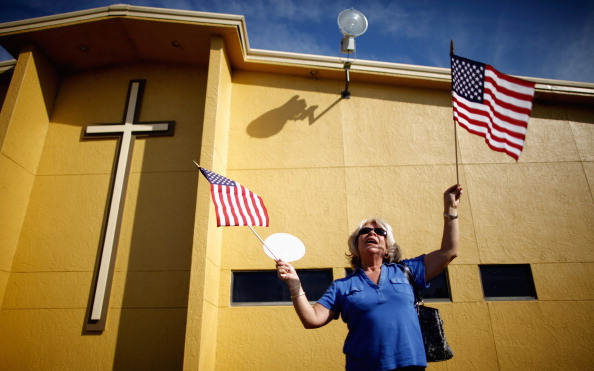Last night’s results show that pollster Robert Jones was far, far too optimistic about the impact of declining numbers of white evangelicals on Senate races in the South. In an October 17 Atlantic piece, Jones identified five races—Arkansas, Georgia, Kentucky, Louisiana, and North Carolina—in which those demographic changes could help either keep Senate seats in Democratic hands, or tip Republican-held seats to the Democrats.
2014, Jones wrote, “may be the year that the underlying demographic trends finally exert enough force to make themselves felt.”
I was skeptical, pointing out that turnout and intensity matter more than these numbers. (Religion News Service’s Tobin Grant disputed Jones’ claim that white evangelicals are declining at all.)
Last night, the Republican Senate candidates won in Arkansas (Tom Cotton defeating Democratic incumbent Mark Pryor), Georgia (Republican David Perdue defeating Democrat Michelle Nunn), Kentucky (incumbent Mitch McConnell handily defeating Democratic challenger Alison Lundergan Grimes), and North Carolina (Republican challenger Thom Tillis defeating incumbent Democrat Kay Hagan). In Louisiana, Democratic incumbent Mary Landreiu is headed for a run-off.
Preliminary exit polling shows that if Jones is right about overall declining numbers of white Southern evangelicals, they nonetheless turned out in much higher percentages than in Jones’ data, exerting an opposite force from the one Jones predicted.
1. ARKANSAS. In his October 17 Atlantic piece, Jones wrote:
In Arkansas, where Republican and freshman Representative Tom Cotton is locked in a tight race with two-term Democratic Senator Mark Pryor, the white evangelical Protestant proportion of the population has dropped from 43 percent to 36 percent.
But preliminary exit polling shows that in Arkansas, 51% of of the electorate was made up of white evangelicals or born-again Christians; 25% of them went for Pryor (who is himself evangelical) while 73% voted for Cotton.
2. GEORGIA. Jones wrote:
In Georgia, where Democratic candidate Michelle Nunn is battling Republican candidate David Perdue for retiring Senator Saxby Chambliss’s seat, white evangelical Protestants made up 30 percent of the population in 2007 but that number is currently down to 24 percent.
Again, preliminary exit polling from Georgia shows that white evangelicals were an outsized share of the electorate, making up 39% of voters. Just 12% of them went for Nunn, 61% for Perdue.
3. KENTUCKY. Jones:
The proportion of white evangelicals in Kentucky has plunged 11 points, from 43 percent to 32 percent; here Senate Minority Leader Mitch McConnell faces the Democratic Alison Grimes, the secretary of state.
But according to last night’s preliminary exit polls, in Kentucky, 52% of electorate were white evangelical or born again Christians. Just 30% of them voted for Grimes, and 68% for McConnell.
4. LOUISIANA. Jones:
In Louisiana, where Republican Representative Bill Cassidy is up against three-term Democrat Mary Landrieu, white evangelicals have slipped from being 24 percent of the population to 19 percent.
In exit polling for Louisiana, where the Senate race is headed for a run-off, pollsters did not ask the “evangelical or not” question. Instead, they categorized all white Protestants into a “white Protestant/other Christian” category; that group comprised 32% of the electorate. Just 14% of them voted for Mary Landreiu, while 21% of them voted for Tea Party favorite Rob Maness and 59% for Republican Bill Cassidy.
5. NORTH CAROLINA. Jones:
Likewise, North Carolina has seen a dip in the white evangelical proportion of its population, from 37 percent to 30 percent; here incumbent Democrat Kay Hagan battles Republican Speaker of the North Carolina House Thom Tillis.
Looking, again, at the preliminary exit poll results for North Carolina, 40% of voters identified as white evangelical or born again; only 16% of them voted for Hagan, and 78% for Tillis, the Republican winner.
As I noted last month, “The religious right spent decades building get-out-the-vote operations and candidate recruitment and training grounds. Those efforts do not vanish with demographic changes, particularly if evangelical turnout is outsized compared to other demographic groups.” That’s why white evangelicals may only make up 32% of the population, as in Kentucky, but make up 52% of the electorate. Turnout matters.





